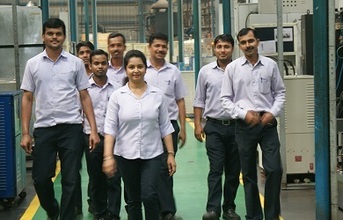
Nirmala on the shopfloor with her colleagues
Tell us something about RSB's skill development and training programmes.
We have a structured process of Learning & Development (L&D) for various skills. The training plans are made by identifying the needs to meet organizational, functional, project role, job, statutory, quality, role-change and customer specifics. Every Plant HR Head carry out a structured exercise, identify the L&D needs of every individual and capture the same in L&D Matrix. This document is used as the primary source to map the training needs of an individual. The matrix is further validated by L&D Role-based Matrix and training calendar, month-wise/week-wise, is rolled out for every location.
The training programs are centrally monitored and measured every month to ensure that desired results are achieved through viva, written examinations and practicals. Gaps, if any, are identified and closed immediately. Periodic review ensures that effectiveness of training is achieved.
It is mandatory for every colleague to undergo training of at least four man-hours per month and is fitted in PMS.
How do you see AI and machine learning impacting manufacturing companies?
AI provides assistance across various human resource functions to automate numerous repetitive processes and work smarter by analysing big data that leads to identifying human resource needs. This makes things easier for shop floor colleagues and managers to interact with software more naturally. For example, software users often prefer to search for things rather than navigate a complex menu. AI makes the software better understand the user's intentions, which makes the system more intuitive, higher productivity and fewer errors.
Future HR strategies will be more on focussing, through AI, creating an agile, employee-focussed and digitally enhanced dynamic environment. It will cover four vital HR Pillars, viz. Attract, Engage, Retain & Develop. This will enhance the efficiency process of attracting right talent and of hiring cycle. AI has widened the scope of traditional recruiting process, introducing virtual assistants for recruiters, thereby making talent acquisition less-time consuming. AI uses massive data base to identify subtle patterns, thereby indicating the precise areas where bias crops up in the hiring process or any people related decision making.
AI will influence Productivity in allied disciplines like selling, production, customer service or any parameter of Balance score card, thereby impacting factors around greater engagement and retention. AI will also shorten the process of duration of PMS.
What are some of the initiatives taken by you to bring more synergy at the Pan Group level?
Our customized HR ERP system plays a major role in standardisation clubbed with our own Internal Portal which is open for all to follow policies and procedures. There is a window to give suggestions. With monthly review with every location through video conferencing, we receive feedbacks and suggestions are implemented after screening internal and local requirements. HR audit at regular intervals gives pulse of the people and valuable input for improvements. This ensures consistency and standardization with built-in flexibility.
What inspires Nirmala, the person and the professional?
As a person, my source of inspiration comes from listening to the voice of heart of all my colleagues with a humane touch, which solves even complicated HR issues by direct interaction. After all, Human Resource & Human Relations are two sides of same coin.
As a professional, I get inspired with all successful people as each of them have different set of traits. This is evident when we look at renowned global leaders where each display different leadership qualities. Learning to inspire begins with discovering and cultivating the latent talents each of us already possess.
END


























